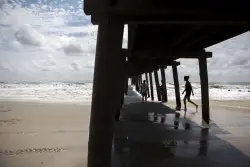Atlanta Suburb Repeals Law Forcing Protestors to Obtain Consent of Anyone Within 8 Feet
You no longer need consent to speak your mind within eight feet of someone in Sandy Springs Ga where the local council repealed one of three controversial new free speech ordinances that were mostly written by the Anti-Defamation League In April the Atlanta suburb in northern Fulton County passed three new ordinances expanding the definition of disorderly conduct which critics without delay flagged as unconstitutional restrictions on First Amendment rights One of the ordinances which was rescinded on Tuesday criminalized handing someone a leaflet displaying a sign or engaging in oral protest within eight feet of someone without their consent The other ordinances which remain in effect make it illegal to obstruct an entrance or exit of a inhabitants facility or private property and to conduct door-to-door soliciting and canvassing between the hours of p m and a m blocking the local Sandy Springs Crier newspaper from delivering papers on its early morning passage A similar law was ruled unconstitutional for violating the First Amendment in the Statesboro Publishing Co v City of Sylvania scenario by the Supreme Court of Georgia The Anti-Defamation League an organization founded to combat anti-Jewish bias and bigotry that has been criticized for falsely conflating criticisms of Israel and advocacy of Palestine with antisemitism drafted the model regulation used to shape the ordinances and in chosen instances the word-for-word language approved by the city council in Sandy Springs The ADL decided to craft these model ordinances to help maintain population safety Sandy Springs Communications and Populace Relations Director Carter Long wrote in an email to The Intercept After the proposed model ordinances were researched and prepared by the ADL they were delivered to the City From there they were taken to City Council work sessions to discuss and ultimately to a City Council meeting to adopt Initial versions of the ordinances were introduced to council members as early as November the month after Hamas October attack on Israel They didn t reappear on the council s agenda until Jan when the bill was presented by Sandy Springs Chief of Police Kenneth DeSimone and City Attorney Dan Lee DeSimone did not initially acknowledge ADL s involvement in modeling the proposed law saying it was a collaboration between himself and the city attorney On April Lee described the ordinance as content-neutral saying it applies to everyone During a work session two council members compared DeSimone s proposed decree and the ADL s model law Council member Andy Bauman read a section from ADL s model ordinance that defined disorderly conduct as when a person knowingly approaches another person within eight feet of such person unless such other person consents for the purpose of passing a leaflet or handbill to displaying a sign to or engaging in oral protest mentoring counseling or harassment with such other person in the inhabitants way within a radius of feet The only difference between ADL s model measure and Sandy Spring s ordinance was that the final language excluded the clause stating in the citizens way within a radius of feet This would later prove consequential Several residents spoke out against the proposed rules such as Mike Petchenik who revealed that while he supports combatting antisemitism these ordinances were throwing the baby out with the bathwater by restricting free speech and freedom of the press It applies to the whole city of Sandy Springs and restricts expression and speech across entire city parameters Representatives of the state chapter of the Council on American-Islam Relations CAIR the nation s largest Muslim civil rights organization revealed Sandy Springs should address real problems including antisemitic flyering in the public but noted that none of the ordinances were fitting solutions and all posed First Amendment issues We believe sufficient laws exist to create safety around building entrances and exits and that the new laws only create complications and legal vulnerabilities that protesters must cope with when exercising their First Amendment rights wrote CAIR-GA Executive Director Azka Mahmood in an email to The Intercept While the canvassing ordinance is likely meant to target Nazis who have been leaving antisemitic flyers in Jewish neighborhoods we know that laws that apply to everyone are inevitably disproportionately applied to people of color who are the majority of scrutinized by law enforcement Mahmood describes the ordinances as tools of suppression aligned with the broader effort detailed by American conservative think tank Heritage Foundation s Project Esther launched in October It is not surprising the ADL is advancing them adds Mahmood The timing of the introduction of the buffer zone ordinances too shows that they are clearly designed to limit people s ability to protest or educate others about Israel s ongoing genocide in Gaza in violation of their right to free speech The ACLU of Georgia warned council members ahead of a populace hearing that the ordinances would violate individuals right to free speech which includes the right to attempt to persuade others to change their views During the citizens hearing Bauman voiced his dismay at the process by which the ordinances were being passed Local attorney David Hudson who represents Appen Media which owns the Sandy Springs Crier urged the council to reject the solicitation ordinance calling it unconstitutional Despite these objections the city council passed all three laws The ordinances aren t the first time the ADL has been involved in Fulton County In March the ADL publicly promoted a Title VI complaint filed against the Fulton County School District by the National Jewish Advocacy Center and the Brandeis Center The complaint which was filed in August and is still pending lists individuals wearing keffiyehs and shouting free Palestine as antisemitic behavior calling the slogan a rallying cry for the eradication of Israel erasing and denying the Jews identity While the complaint references an matter in which a candidate allegedly attempted to start a physical altercation it largely focuses on pro-Palestinian symbols and messaging in its claims of antisemitism It highlights teachers who wore Free Palestine pins and Palestinian pendants that the complaint proposes erases the State of Israel The lawsuit also calls out teachers anti-Zionist perspectives being shared with students Officers in Sandy Springs Ga based their local ordinances on proposals drafted by the Anti-Defamation League Photo Aja Arnold The ADL has filed similar lawsuits with Brandeis Center including the April complaint against Yale University This new series of complaints filed and promoted by ADL largely targets colleges and universities Fulton County is the only school district listed in ADL s press declaration boasting its new litigation battles Meanwhile two Muslim advocacy groups also filed a civil rights complaint against the district in February alleging the district hasn t done enough to protect its Palestinian students The ADL has a long legacy of pushing model measure to national state and local governments In its Hate Crime Laws record the organization stated that states and the District of Columbia had enacted laws similar to or based on the ADL model In the ADL s model rule efforts made precedence in the U S Supreme Court when the court upheld a Wisconsin hate crime statute based on model provision drafted by the organization in It s not the first time the city of Sandy Spring embraced ADL model provision In the aftermath of the Charleston church shooting in the ADL launched a hate crime law campaign States Against Hate with Georgia as a key target In Sandy Springs became the first city in Georgia to ratify a local hate crime ordinance Less than two months after the trio of speech ordinances were passed the City Council in Sandy Springs gathered again to discuss one of the buffer zone laws This time Lee the city attorney offered a different perspective Despite his initial advocacy of ADL s model legislations Lee initiated a recommendation to repeal the controversial ordinance Lee argued that the Sandy Springs ordinance as written stipulated that barrier zones were floating rather than one tied to a geographic point That s because the City Council trimmed the clause from the model language requiring buffer zones within a -foot radius of fixed points say a regime building or a house of worship That meant that rather than having -foot buffers at protests the entire city would be blanketed in constantly moving -foot buffers restricting speech without consent from passersby In a May memo to the mayor and council members Lee expressed concern this could open up Sandy Springs to a heap of lawsuits Since the adoption of the ordinance there has been much discussion among and between legal and interested parties wrote Lee The ADL and ACLU believe that the removal of the fifty foot radius provision presents a challenge to this particular Ordinance He continues in saying that the buffer zone as agreed between ADL and ACLU must be directly tired to a geographic point and not floating Lee added that the other two ordinances passed at the same time are sufficient valuable tools to protect the population Addressing the council in the dark after a power outage disrupted the meeting ACLU director Cory Isaacson described the measure as too far-reaching Instead of being narrowly tailored the ordinance is as broad as it can get Isaacson reported moments before the blackout It applies to the whole city of Sandy Springs and restricts expression and speech across entire city parameters The council voted unanimously to repeal the measure To Emmaia Gelman the director of the Institute for the Critical Survey of Zionism it s no surprise the ADL was involved in pushing rule that put obstructions on speech It s more of the same from the anti-left anti-communist organization Gelman announced only now it s coming at a time when asserts of antisemitism are being weaponized by an increasingly authoritarian ruling body to stifle dissent At the time of this publication the ADL media office did not respond to request for comment What we have here is the ADL criminalizing another aspect of protest at a time when the policing of protest is super heightened incredibly violent and being used to advance fascism reported Gelman The material impacts of doing that right now are so clear And who is being policed It s protesters who are opposing the Israeli genocide and over-policing While the ordinance is repealed for now certain advocates worry that the door remains wide open for the city to again collaborate with the ADL to enact the model regulation The only reason this ordinance was repealed is because it deviated from its original text stated Mahmood We remain concerned that it will be re-introduced in its intended form The post Atlanta Suburb Repeals Law Forcing Protestors to Obtain Consent of Anyone Within Feet appeared first on The Intercept

